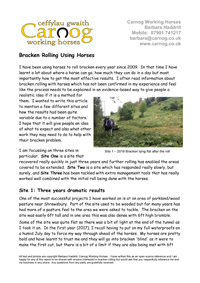- Home |
- Horse Logging |
- Bracken Control |
- Charcoal |
- Training/Demos |
- Harrowing |
- Equipment |
- Experience |
- Horse Tales |
- Contact Us |
- Links
Bracken Control
Bracken is a common problem for many landowners and woodland managers which Carnog Working Horses can help solve in a low-impact way.
Bracken is such an invasive species that it can quickly take hold and diminish valuable grazing land or impair woodland regeneration. A variety of methods have been tried in the past from cutting to poisoning with chemicals flown in by plane or sprayed by hand. Bracken bruising using a horse-drawn roller is the ultimate, low-impact method and can be extremely effective if carried out correctly, at the right time and combined with other management interventions. It can also be carried out whatever the weather, unlike chemical treatments.
 Carnog Working Horses have been rolling bracken for 13 years now and have worked on a variety of different sites, all with differing problems and limitations. I have recently written a report (click here or on the image left to open in a new screen) to show some of the evidence of the bracken rolling work we have undertaken.
Carnog Working Horses have been rolling bracken for 13 years now and have worked on a variety of different sites, all with differing problems and limitations. I have recently written a report (click here or on the image left to open in a new screen) to show some of the evidence of the bracken rolling work we have undertaken.
We work closely with the landowner to give them a realistic idea of how the process will work and encourage them to undertake other management work to assist too, such as reintroducing grazing from native breed cattle and ponies, reducing scrub cover and also raking off any deep litter, more details below. Bracken rolling alone will work, but will be much slower if other work is not carried out as well.
Other methods that are employed as extremely destructive to the environment; chemicals are not only expensive but costly to the environment as well. When the common chemical Asulox comes into contact with a water source, it becomes very toxic indeed. In addition bracken often grows on hard to reach, remote and steep sites which are inaccessible by tractor or quad bikes. Cutting bracken actually stimulates it's growth and so multiple cuts are required in a season, which would include during the flowering season for many important wildflowers, as well as nesting birds and local wildlife will struggle to get out of the way as the mower comes over quickly.
Horse drawn bracken bashing is extremely effective with low-impact, avoiding chemicals, causing no damage to the surrounding environment. It can be carried out whatever the weather and the timing also coincides with better protection for other wildlife on the site. Carnog Working Horses use an award-winning roller to bruise the stems and knock the plant flat to the ground. It slowly 'bleeds' to death and is substantially knocked back. Depending on how vigorous the plant was and how dense the growth is, as well as other management methods, the bracken can be substantially diminished within three seasons.
The prime time for horse-drawn bracken rolling is any time from mid-June to mid-August, for our geographical location and we will advise people on the best time for their site, based on our experience and after a site visit. If the work is completed before the end of June, we are mindful that it is bird nesting season and so liaise with the landowner to establish if there are any birds known to be nesting and we can avoid those areas. The roller moves very slowly and so other wildlife can easily move out of the way. Other important flowers, ferns and tree saplings are not affected and bounce back up after the roller has passed.
We have developed a lot of experience over the years of what works best and what is less effective. The re-introduction of grazing is by far the best way to help speed up the process of bracken reduction and also to maintain the site from returning to a bracken covered state again in the future. We have found Highland cattle and Dexters are very effective at not only speeding up the degrading of the litter after we have rolled and also nibbling up any brambles that often come in as the bracken starts to diminish. On sites where grazing is impossible, we have experimented with raking up the bracken litter and removing it from the site: this has shown enormous benefit to aiding other plants to establish and take over from the bracken. As part of the clearance of the litter, we also use the horses to clear the site of small trees as in the short video below.
From our base in the Tanat Valley near Llanrhaeadr-ym-Mochnant, we find that there is a high demand for bracken rolling, so contact us soon to book us for work. Barbara Haddrill featured in the local Blewyn Glas magazine with a report by Meic Llewellyn and also in the Shropshire Star on 27th July 2013 bashing bracken at the Nant Mawr Nature Reserve for the Shropshire Wildlife Trust to help promote the pearl-bordered fritillary.

